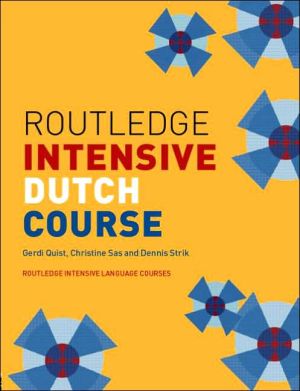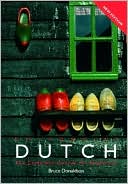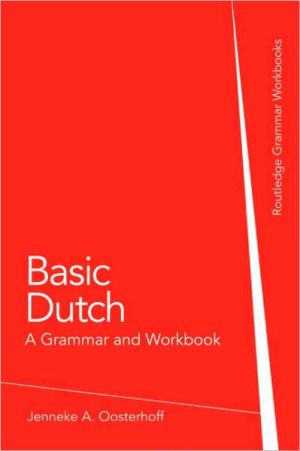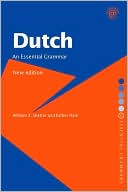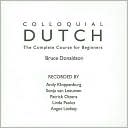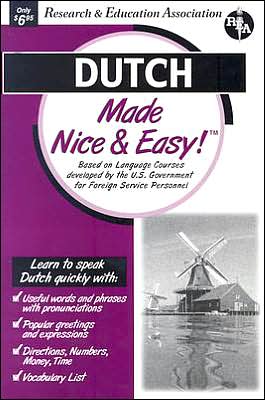Routledge Intensive Dutch Course
This intensive foundation course in Dutch is designed for those with no previous knowledge of the language. It is lively and fast-paced, providing students with a wide range of activities, and drawing on an impressive selection of source material from many different media. Audio materials are presented on accompanying CDs, to be purchased separately.\ Taking students from beginner to intermediate level in one year, the Routledge Intensive Dutch Course develops a thorough working knowledge of...
Search in google:
This intensive foundation course in Dutch is designed for students with no previous knowledge of the language. It is lively and fast-paced, offering students a wide range of activities, and drawing on an impressive selection of source material from many different media. Audio materials are presented on accompanying cassettes.Students using the Routledge Intensive Dutch Course will practice the four key skills of language learning - reading, writing, speaking, and listening - and will acquire a thorough working knowledge of the structures of Dutch.The Routledge Intensive Dutch Course takes students from beginner to intermediate level in one year.Guidance for tutors as well as links to related sites will be available at www.routledge.com/intensive/dutch.
CHAPTERTOPICS FUNCTIONS GRAMMAR1. HIER BEN IKIn this chapter you will learn to talk about yourself and how the ways that you use the language also gives away something about yourself (and others). You will also learn about various conventions used when greeting people. We will look at what you actually 'do' when you use language: which functions and tasks you perform, and what strategies you can use for writing, depending on what impression you want to achieve. 2. SAMENLEVENIn this chapter you are encouraged to think about the way that the tone in which you talk conveys messages in its own right. This chapter focuses on communications between people living together and the practical issues which arise when people interact and which need to be resolved. In this chapter you will also learn about the little words that colour your language use and can change or modify meaning.3. OP STRAATIn this chapter you will learn practical functions of everyday activities in the outside world. You will see that even in simple and straight forward activities such as shopping for clothes, the language you use conveys more than you think.4. GROEPSGEDRAGIn this chapter you will look at ways in which language is used in specific, set ways within particular groups, such as families, particularly in the context of group gatherings and celebrations. In this chapter you will also learn how official texts are written in order to get the point across to certain groups of people.5. IK EN MIJN WERELDThis chapter looks at how people express their identity and their view of the world through what they like and what they do. We will look at how different types of texts,for instance from a a serious film magazine or a popular weekly magazine, use different kinds of language. Finally, we will look a some strategies for reading. 6. WERKKLIMAATThis chapter focuses on the world of work. You will study the way people talk about work and the various modes of communication at work such as e-mails. This chapter looks at how style and language use reflect relations at work: between employer and staff and between company and customer. We also look at ways of inviting people and how these reflect professional relationships. In addition, the chapter offers an opportunity to talk about personal development in a work context. Finally, some differences between Dutch as spoken in the Netherlands and in Flanders are discussed. 7. OPEN GORDIJNENThis chapter focuses on talking about the communities where people live or have lived, and the relationships they have with the people around them, particularly their immediate neighbours. We will also look at how people talk about their lifestyle. Furthermore, we will look at how language use affects objectivity and subjectivity.8. IK DOE WAT IK WILThis chapters takes the issue of identity and language use into such areas as talking about immigration, integration and individualism.We delve below the surface to look at implicit messages people leave in their writing about, for instance, the identity of an organisation or their ideas about male and female relations. You will also learn how to structure texts and how to make stylistically effective descriptions depending on what you want to achieve with your messages.9. TYPISCH NEDERLANDS?In this chapter we will focus on discussions of national identity and what the Dutch themselves and others consider "typically Dutch". We look at the problems of talking about national identity, and whether such a thing is possible at all. We look at some historical issues which are considered to have shaped the Netherlands and we will look at how different newspapers represent events from different perspectives. In addition you will learn more strategies for writing.10. VLAANDERENThis chapter will give you more information about things which are considered to be typically Flemish, but moreover it will look at how Flemish people talk and think about themselves , particularly in relation to the Dutch.We will look at popular culture typical of Flanders and Belgium and we will read a wide range of texts, practising the language in a wide range of tasks, both practical and creative11. NEDERLAND IN BEWEGINGThis chapter focuses on current political and social affairs in the Netherlands. We will look at various public debates taking place, and how different viewpoints shape the language people use in presenting their ideas.You will see examples of different strategies for presenting ideas, including humor. We will also take another look at making texts more coherent, by practising writing texts for different contexts. This chapter also includes various revision exercises and a self-evaluation.
